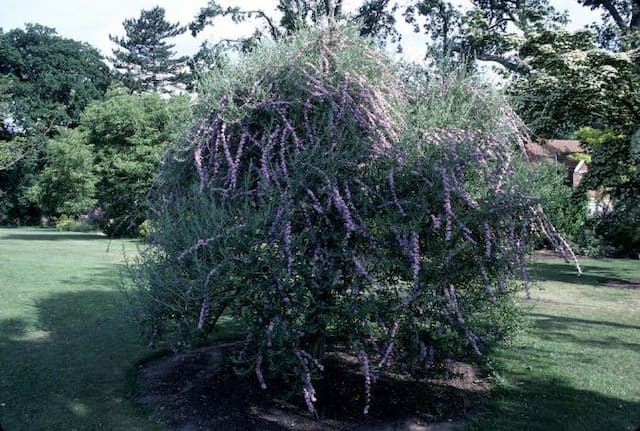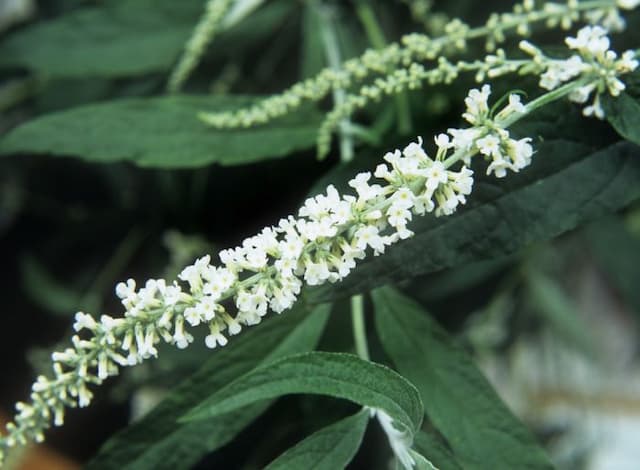Cape Fuchsia Phygelius × rectus Somerford Funfair Orange = 'Yapor' (Somerford Funfair Series)
![Cape figwort [Somerford Funfair Orange]](/_next/image?url=https%3A%2F%2Fplants-admin.emdemapps.com%2Fimages%2Fplants%2F%2Fimages%2F604b5d0a31d50.png&w=3840&q=75)
ABOUT
The plant in question, commonly referred to as Cape Fuchsia, holds a vibrant charm that is sure to captivate any onlooker. It is characterized by its striking trumpet-shaped flowers, which boast a luminous orange hue. The vivid blossoms are arranged in clusters, gracefully nodding at the tips of the stems and providing a sense of movement within the garden space. Amidst the flowers, the dark-green leaves present a lush backdrop, highlighting the brightly colored blooms and giving the plant a full, bushy appearance. The leaves themselves are long and glossy, with a slightly serrated edge that adds texture to the foliage. While the primary draw of the Cape Fuchsia is its flowery show, the stems also contribute to its beauty with their semi-upright bearing, offering an elegant and structured look to the plant's overall form.
About this plant
 Names
NamesFamily
Scrophulariaceae
Synonyms
Cape Fuchsia, Cape Figwort
Common names
Phygelius × rectus 'Yapor'.
 Toxicity
ToxicityTo humans
Cape fuchsia is not widely reported as a toxic plant to humans. However, as with many plants, individual sensitivities can vary and it is possible that some people might experience mild stomach upset or dermatitis after ingesting or handling the plant. If you suspect poisoning, seek medical advice.
To pets
Cape fuchsia is not specifically listed as toxic to pets. Nevertheless, it is advisable to prevent pets from ingesting plants, as they may cause gastrointestinal upset or other issues due to individual sensitivities. If you observe symptoms of distress in your pet after ingestion, such as vomiting, diarrhea, or unusual behavior, consult a veterinarian.
 Characteristics
CharacteristicsLife cycle
Perennials
Foliage type
Semi-deciduous
Color of leaves
Green
Flower color
Orange
Height
2 feet 3 inches (0.69 meters)
Spread
2 feet (0.61 meters)
Plant type
Shrub
Hardiness zones
9
Native area
South Africa
Benefits
 General Benefits
General Benefits- Attractive Blooms: Phygelius x rectus 'Yapor' is known for its striking orange flowers that add vibrant color to gardens throughout the summer and into the fall.
- Long Flowering Period: This cultivar has a lengthy blooming season, providing ongoing interest and beauty in a garden setting.
- Wildlife Attraction: The flowers of the Cape Fuchsia can attract hummingbirds and beneficial pollinators, which can help with the pollination of surrounding plants.
- Drought Tolerance: Once established, the Cape Fuchsia is relatively tolerant of drought conditions, making it suitable for xeriscaping and water-efficient landscaping.
- Low Maintenance: It generally requires minimal care beyond the basic needs, making it ideal for both novice and experienced gardeners.
- Versatility: Suitable for borders, containers, and as an accent plant, Cape Fuchsia is versatile in landscaping uses.
- Deer Resistance: The plant is often resistant to deer, which can be particularly beneficial in areas where deer browsing is a problem for gardens.
- Fast Growth: It has a relatively fast growth rate, allowing for quick establishment and filling in of garden spaces.
 Medical Properties
Medical PropertiesThis plant is not used for medical purposes.
 Air-purifying Qualities
Air-purifying QualitiesThis plant is not specifically known for air purifying qualities.
 Other Uses
Other Uses- The Cape fuchsia can be used in cut flower arrangements due to its vibrant color and unique tubular flowers, adding a touch of the exotic to any bouquet.
- This plant serves as an accent in mixed containers, providing an upright and bright presence among other plants.
- The plant can act as a natural hummingbird attractor due to its nectar-rich flowers, making it ideal for creating a hummingbird garden.
- Its long flowering season makes the Cape fuchsia an excellent option for gardeners seeking to maintain sustained color in their garden beds from summer into fall.
- When grown in large groups, the Cape fuchsia can function as a semi-informal hedge that requires minimal pruning due to its natural bushy growth habit.
- The Cape fuchsia's foliage can be a unique addition to a foliage-only garden, offering structure and contrast against different leaf shapes and textures.
- It has the potential to be used in coastal gardens as it can tolerate seaside conditions better than some other garden plants.
- By planting the Cape fuchsia in areas susceptible to erosion, its roots can help stabilize the soil.
- For educational purposes, the plant can be used to teach about pollination, as it is easily pollinated by birds and insects due to its shape and nectar production.
- The Cape fuchsia can be incorporated into a sensory garden, as its flowers are interesting up close both visually and texturally.
Interesting Facts
 Feng Shui
Feng ShuiThe Cape Fuchsia is not used in Feng Shui practice.
 Zodiac Sign Compitability
Zodiac Sign CompitabilityThe Cape Fuchsia is not used in astrology practice.
 Plant Symbolism
Plant Symbolism- Optimism: The vibrant orange color of the Cape Fuchsia is reminiscent of a joyful, sunny disposition, often associated with a positive outlook and enthusiasm.
- Attraction: Cape Fuchsia's showy blossoms can symbolize an alluring charm or magnetic attraction, drawing in both pollinators in nature and admiration from onlookers.
- Energy: The fiery orange hue represents energy and vitality, fitting for a plant that can add a splash of vigorous color to gardens or landscapes.
- Eccentricity: The unique shape and intense color of the Cape Fuchsia could signify an eccentric or unconventional quality, celebrating the beauty of being unique or non-conformist.
- Warmth: Like a cozy fire or the warmth of the sun, this plant's warm-toned flowers exude a sense of comfort and hospitality.
 Water
WaterFor the Cape Fuchsia 'Somerford Funfair Orange', water the plant deeply and thoroughly to ensure that the water reaches the roots. Ideally, watering should be done early in the morning to reduce evaporation and allow the foliage to dry before nighttime, which can help prevent fungal diseases. During the active growing season in spring and summer, water the plant once a week, providing about 1 gallon of water per watering session for an average-sized plant. Adjust the frequency depending on weather conditions, watering more often during hot, dry periods and less during cooler, rainy spells. Avoid overwatering by allowing the top inch of soil to dry out between watering sessions.
 Light
LightCape Fuchsia 'Somerford Funfair Orange' thrives in full sun to partial shade. It prefers to be in a location that receives at least six hours of direct sunlight per day. If planted in too much shade, the plant may not produce as many flowers and could become leggy. Morning sunlight with afternoon shade can be beneficial in hotter climates to prevent stress from intense heat.
 Temperature
TemperatureCape Fuchsia 'Somerford Funfair Orange' can handle a wide range of temperatures, but it performs best in conditions that mimic its native climate. The ideal temperature range for this plant is between 50°F and 75°F. It can tolerate minimum temperatures down to about 20°F but should be protected from frost. During hot summer days when temperatures exceed 90°F, providing some afternoon shade can help protect the plant from heat stress.
 Pruning
PruningCape Fuchsia 'Somerford Funfair Orange' should be pruned to maintain its shape and encourage bushier growth. Prune the plant in late winter or early spring before new growth begins. Remove any dead or damaged stems and cut back the plant by about one-third to promote fresh growth and more abundant blooms. Pruning can be done annually, and occasional deadheading during the blooming season can encourage more flowers.
 Cleaning
CleaningAs needed
 Soil
SoilCape Fuchsia 'Somerford Funfair Orange' thrives in well-draining soil enriched with organic matter, ideally a mix of two parts garden soil, one part compost, and one part perlite or sand. The ideal soil pH for this plant is between 6.0 and 7.0.
 Repotting
RepottingCape Fuchsia 'Somerford Funfair Orange' typically needs repotting every 2-3 years to refresh the soil and accommodate root growth.
 Humidity & Misting
Humidity & MistingCape Fuchsia 'Somerford Funfair Orange' prefers moderate humidity levels, but it is quite adaptable and can tolerate the varying humidity levels commonly found in most homes.
 Suitable locations
Suitable locationsIndoor
Place in bright, indirect light and ensure good airflow.
Outdoor
Full sun to partial shade; shelter from strong winds.
Hardiness zone
9-11 USDA
 Life cycle
Life cyclePhygelius × rectus 'Yapor', commonly known as Cape Fuchsia 'Somerford Funfair Orange', begins its life cycle as a seed that, when sown in fertile, well-draining soil, germinates into a small seedling. As the seedling matures, it develops into a bushy perennial with sturdy stems and deep green leaves. During the flowering stage in late spring to summer, it produces tubular, bright orange flowers attractive to pollinators like hummingbirds and bees. After pollination, the flowers may develop into small, inconspicuous seed capsules that release seeds for propagation. In colder climates, Cape Fuchsia 'Somerford Funfair Orange' may die back to the ground in the winter but will resprout from the roots in spring. Over its lifespan, the plant can be propagated by division or cuttings to create new plants, enabling it to spread and continue its life cycle.
 Propogation
PropogationPropogation time
Spring-Early Summer
The most popular method for propagating Cape Fuchsia 'Somerford Funfair Orange' is through semi-ripe stem cuttings during late spring or early summer when temperatures are mild and conducive for growth. To do this, a gardener would take a cutting about 4 to 6 inches (approximately 10 to 15 centimeters) long from a healthy parent plant. The lower leaves of the cutting are removed and the base is dipped into rooting hormone to encourage root development. This cutting is then placed in well-draining soil or a container with a mixture of peat and perlite. The cutting should be kept moist and in a warm, shaded environment until roots have developed, which typically takes a few weeks, after which it can gradually be acclimatized to direct sunlight and eventually transplanted into the garden.



![Butterfly bush [Florence]](/_next/image?url=https%3A%2F%2Fplants-admin.emdemapps.com%2Fimages%2Fplants%2F%2Fimages%2F604b5f52d7bb1.png&w=640&q=75)
![Butterfly bush [Nanho Blue]](/_next/image?url=https%3A%2F%2Fplants-admin.emdemapps.com%2Fimages%2Fplants%2F%2Fimages%2F604b55d0a6d2d.png&w=640&q=75)




